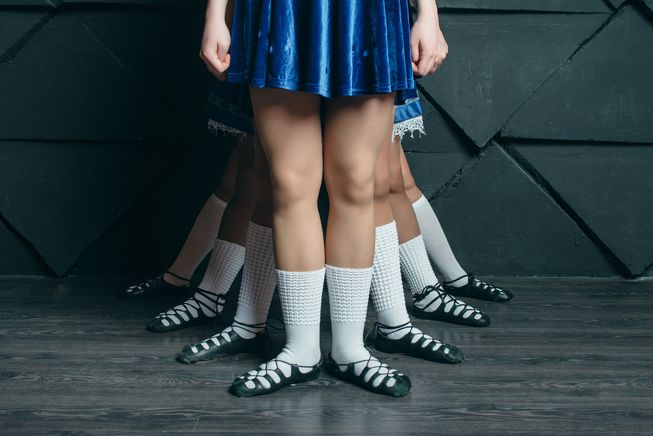为什么帕金森氏症患者可以毫不费力地跳爱尔兰舞
Could Irish dancing be the next medical frontier in the fight against Parkinson's disease?
爱尔兰舞蹈会成为对抗帕金森氏症的下一个医学前沿吗?
Daniel Volpe thinks so.
丹尼尔·福克斯这么想。
And he knows a thing or two about both. He's head of the Parkinson's rehabilitation unit at St. John of God Hospital in Venice, as well as an accomplished musician.
他对这两件事都略知一二。他是威尼斯圣约翰神医院帕金森氏症康复中心的主任,同时也是一位颇有成就的音乐家。

Irish dancing requires strict control of the upper body, while the legs and feet go to town. (Photo: Caracatitsa/Shutterstock)
According to the Irish Post, Volpe had a revelation while he was performing at an Irish dance hub back in 2010. A man who was obviously living with Parkinson's got on the dance floor. And, as the newspaper recounts, "the man who walked so unsteadily required no assistance to dance. Indeed, the man went through the moves effortlessly, as if he were a different person."
据《爱尔兰邮报》报道,早在2010年,沃尔普在爱尔兰的一个舞蹈中心表演时就有了灵感。一名明显患有帕金森症的男子走上了舞池。而且,正如报纸所述,“走路如此不稳的人不需要别人帮助就能跳舞。”事实上,这个男人毫不费力地完成了这些动作,就好像他是另外一个人一样。”
Irish dancing often involves keeping one's upper body and arms relatively stationary while the legs — particularly the feet — get extremely busy. It's sometimes likened to tap dancing.
爱尔兰人的舞蹈通常包括保持上半身和手臂相对静止,而腿——尤其是脚——非常忙碌。有时它被比作踢踏舞。
Think, Riverdance — an Irish dance production that carried the ancient tradition to the world on its twirling, whirling legs.
想想看,《大河之舞》——这是一部爱尔兰舞蹈作品,通过旋转的腿把古老的传统带到了世界各地。
The frequent changes in direction, along with measured step lengths mean an Irish dancer is always alternating weight from one leg to another.
在方向上的频繁变化,以及测量的步长意味着一个爱尔兰舞者总是交替的重量从一条腿到另一条腿。
You might think that a progressive nervous system disorder like Parkinson's would make such complex movements difficult, if not impossible.
你可能会认为,像帕金森氏症这样的渐进性神经系统紊乱会使这种复杂的动作变得困难,如果不是不可能的话。
But the man Volpe saw dancing made it seem effortless.
但是沃尔普看到的跳舞的人使它看起来毫不费力。
So when he returned to Italy, he donned his medical hat — and conducted a study published in BMC Geriatrics involving 24 Parkinson's patients. Dividing the group in half, his team administered conventional physiotherapy to 12 patients. The other contingent was taught to dance.
所以当他回到意大利时,他戴上了医生的帽子,并进行了一项发表在《英国医学委员会老年病学》上的研究,涉及24名帕金森患者。他的团队将患者分成两组,对12名患者进行常规物理治疗。另一支队伍被教跳舞。
At the conclusion of the six-month trial, researchers noted the unlikely Irish dancing troupe edged out their counterparts in every category of bodily control. Physiotherapy was still effective in helping patients control their movements, but Irish dancing appeared even more so.
在为期六个月的试验结束时,研究人员注意到,这个不太可能的爱尔兰舞蹈团在身体控制的各个方面都胜过了他们的对手。物理疗法在帮助病人控制他们的动作方面仍然有效,但爱尔兰舞似乎更有效。
"Although improvements were made in both groups, the dance group showed superior results to standard physiotherapy in relation to freezing of gait, balance and motor disability," the researchers noted in the study.
研究人员在研究中指出:“尽管两组都有改善,但在步态冻结、平衡和运动障碍方面,舞蹈组的效果优于标准物理疗法。”
Volpe theorizes that the music itself — a lilting rhythm with clear patterns — may help patients navigate the dance. Those patterns could allow the cerebral cortex to to bypass certain regions that control motor skills.
沃尔普的理论是,音乐本身——轻快的节奏和清晰的模式——可以帮助病人驾驭舞蹈。这些模式可以让大脑皮层绕过某些控制运动技能的区域。
In a sense, patients feel the music, and that means Irish eyes — and Irish minds — are smiling.
在某种意义上,病人能感受到音乐,这意味着爱尔兰人的眼睛和思想在微笑。







